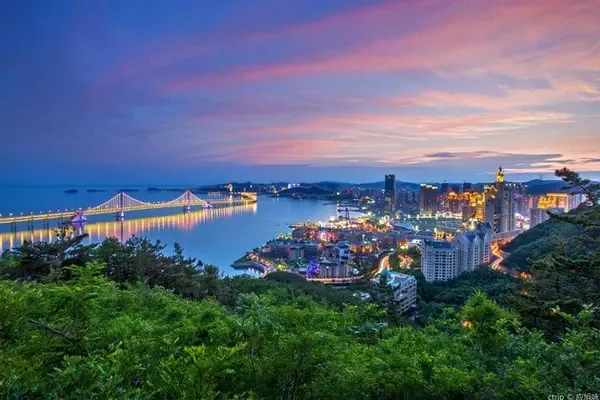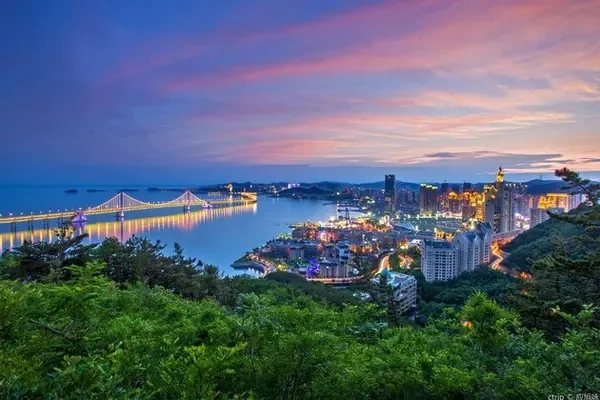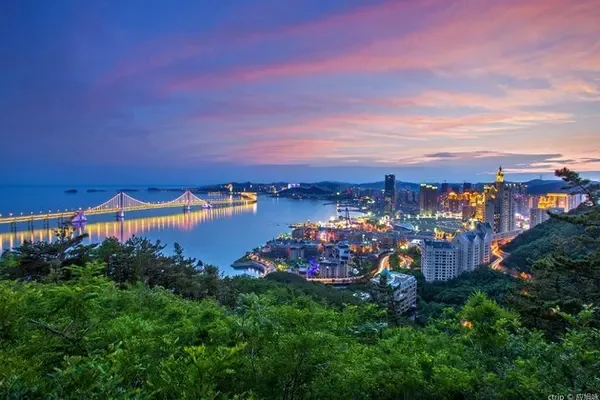★Tourist location: Guansuoling, Guanling County, Anshun, Guizhou
Going down from the Shimen downstairs of the Imperial Book Building, there are walls built of stone blocks on both sides, and an arch in the middle. Although the style is very simple, it looks a bit quaint. Going down the stone steps, the green trees here are shaded, the trees are lush and the grass is deep, and the cool breeze is blowing, which relieves a lot of heat all at once. Standing in front of the arch and looking out, there are many peaks and mountains in the distance, the mountains are rolling and rolling, and the mountains are covered with verdant forests. With the blue sky and white clouds, it is simply a natural oil painting.
All the way downhill, the eyes became clearer and clearer. The slope of this road made of stone steps is gentle, and walking is not strenuous. I just searched for the Killing Ping Ruins and Tanhua Tomb according to the map. I had already found the location of the sign, but I looked around, but I couldn't see the appearance of the ruins. The surrounding area is full of dense vegetation, and occasionally there are a few clusters of red fruits with bright colors, which are really beautiful, but there is no introduction to the relevant attractions. Perhaps the so-called ruins have been lost in the long river of history.
At this time, I had already descended to the half slope, and seeing a mountain depression ahead, I felt a little worried, wondering if there would be a road ahead. Checked the map, it seems to lead to the visitor center. To be honest, at this time our water has run out and our throats are very dry. The little friend proposed to go back the same way, but thinking that we have climbed a mountain all the way down, and we have to climb the mountain at this time. This scenic spot that has not been fully developed does not have any selling points. I took out the map and checked it. I was very pleased to find that there was a visitor center along this road. It seems that we hit the gate by mistake! Since there is a visitor center, there must be a bus, right?
So we continued to move forward, not far away there is a brief introduction to Shuangquan Temple, which was built in the early Ming Dynasty. The scale of the temple cannot be seen now, only a section of ruins remains, the arches are also dilapidated, and the walls on both sides are almost collapsed. However, at any rate, this place also looks like a ruins.
According to legend, Zhuge Liang of the Three Kingdoms went south to suppress the rebellion, and Guan Suo, son of Guan Yu and general of the Shu Kingdom, led his troops to station here. One day, Guan Suo came to the mountain while chasing the rebels. It was noon and the sun was scorching. It was estimated that the weather was similar to today's, maybe even hotter. The soldiers and horses were all thirsty. At this time, Guan Suo's war horse suddenly broke free from the rein, and was digging wildly among the pile of rocks. The soldiers were all puzzled, and there was a sound of "wow", and a stream of clear spring water gushed out from the chaotic rocks. Guan Suo couldn't help being pleasantly surprised: "A horse can dig a well, but a man is not as good as a horse?" So he took a knife and poked the ground hard, and another clear spring gushed out immediately. For the thirsty soldiers of the Shu army, it was like rain after a long drought. So the soldiers drank happily, boosted their morale, and took down the pass on the top of the mountain in one go. Later, the local people named it "Guansuoling". In the early Ming Dynasty, a temple was built here, and the two springs were named after "Mashai Well" and "Daoba Well". In the Qing Dynasty, it was renamed "Longquan Temple". When Xu Xiake arrived here, the temple still existed. He called it "Guanyin Pavilion" in his travel notes. It can be seen that although it is called a temple, the scale is still small, mainly to commemorate these two springs.
Continue down, there is a viewing platform here. It is said to be a viewing platform, but it is actually just a slightly flat place, and the terrain is not open, but you can see the Baling Bridge very clearly. At this time, the houses on the hillside can be seen clearly, but there seems to be no road ahead just walking. Fortunately, I saw a villager working in the field and hurriedly asked, saying that I could go down here to take a bus, but it was still several kilometers away from the bus point.
We were a little dumbfounded: "How about going back the same way?" The villagers shook their heads at us: "You have to climb over a mountain when you go back. It's a bit far from here, but the road is easy to walk, there is no mountain road."
We hesitated for a while, but chose to move on, mainly because we didn't want to go back. Since there is a road ahead, let's go forward bravely, at least you can see a different scenery if you go forward!
Going down to the bottom of the mountain, there is an introduction to the Ancient Tea Horse Road, which seems to be more formal than the place we came up from. On the side is the ruins of the Baling Bridge. This bridge, which was built in the early Ming Dynasty, was rebuilt during the Daoguang period of the Qing Dynasty. Because there is an eight-faced column stele at the head of the bridge, the locals also call it "Eight-Length Bridge". Calling and calling, it becomes the Baling Bridge. On the eve of liberation, when the Kuomintang army was defeated and bombed, a hole was blown up, so the ancient bridge was abandoned. Later, the government allocated funds to repair the broken hole, but the quality of the project did not pass the test. It was washed away by the flood that year, and now we can only see two holes. The plants beside the bridge grow very luxuriantly. After all, the climate near the water is pleasant, so there is no need to worry about drought, and the plants grow naturally and well.
I don’t know if the not-so-deep river next to the bridge is the Baling River. The water quality looks very clear, and the green trees and grass on the bank are very lush. The visitor center indicated on the map has not been built yet, so we naturally lost the opportunity to replenish the water source. Seeing that there is still a lot of distance from the residential area, we can only walk forward helplessly when we get here.
The road was really flat, without any slope, but my throat was so dry that it almost smoked, and I wished I could go to the river to quench my thirst with a handful of water. Speaking of Shuangquan, we really didn't see the spring water, maybe it was blocked? My friend reminded me very seriously: "There are many parasites in raw water." Well, even though my throat was thirsty, I didn't have the courage to go to the river to drink raw water.
There are some crops beside the road. If there is a sugar cane at this time, no matter how thick the skin is, I can break it and suck the juice. Corn and melons were planted next to it, but they looked like pumpkins, so they couldn't be eaten raw... After walking for a while, I saw a row of tomatoes, which didn't look good and were a little cracked. I hurriedly took one off, but fortunately there were still wet tissues in my backpack, so I didn’t care about being particular about it at this time, so I just wiped the skin with a tissue and ate one with the belt juice, and then I extinguished the smoke in my throat.
I looked around and wanted to find a villager and buy a bag. This thing has almost no sweet taste, but for me who is thirsty, it is really a good thing to quench my thirst. It's a pity that there was no one on the road, and I didn't have the nerve to pick another one. Although the tomatoes growing near the roots are really not very attractive, they probably won't be sold.
The little friend said that he could still persist, and rejected my suggestion to pick one for him. Eating a small tomato relieved my thirst to some extent, and only then did I start to have leisure time to enjoy the scenery on the river bank. In fact, the scenery here is really good. There is a kind of banana plant beside the road with quite beautiful white flowers. The river flows slowly, with a slight slope. There are some protruding stones in the middle of the river, which add some fun to the river.
After walking for several kilometers, I finally saw the village, but I didn't see any grocery store or non-staple food store along the way. But some people can finally ask for information, only to know that they can stop the car at the roadside to go to Guanling County not far ahead. Hope is right in front of us, and our heavy steps are finally a little lighter. I asked a few people along the way, and reconfirmed that there is indeed a shuttle bus to Guanling passing by here, so I can feel at ease.
There is no waiting sign on the side of the road, but we are used to it. This is the case in many places in Guizhou. You need to ask the locals to know where to wait. Fortunately, it wasn't too late, otherwise we would really have to worry about sleeping rough. After waiting for about half an hour, I waited for a minibus. Unexpectedly, we just crossed a mountain, and there are still more than ten kilometers to go back to Guanling...























